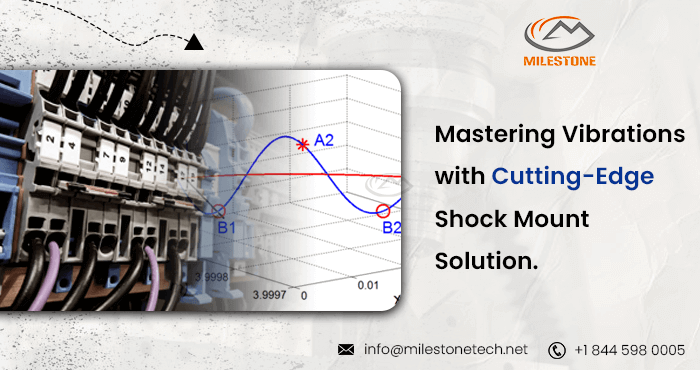Mastering Vibrations with Cutting-Edge Shock Mount Solution
In the dynamic world of engineering, managing vibrations is a critical aspect of ensuring the longevity and efficiency of structures and machinery. The impact of vibrations can be far-reaching, affecting not only the immediate surroundings but also the overall performance of equipment and structures. To address this challenge, engineers and professionals in the field are turning to cutting-edge shock mount solutions, revolutionizing the way vibrations are controlled and managed.

Understanding Vibrations in Engineering:
Vibrations are inherent in many engineering applications, ranging from heavy machinery operation to the structural integrity of buildings. These oscillations can lead to fatigue and wear-and-tear, compromising the reliability of equipment and structures over time. In industries such as construction, where precision and stability are paramount, mastering vibrations has become a key focus area.
Traditional Approaches vs. Cutting-Edge Solutions:
Historically, engineers relied on traditional methods such as damping materials and isolation pads to mitigate vibrations. While these methods have been effective to some extent, they often fall short in addressing the complexities of modern engineering challenges. Enter cutting-edge shock mount solutions, a new frontier in vibration control that leverages advanced materials and technologies.
Key Features of Cutting-Edge Shock Mount Solutions:
- Smart Sensing Technology: Modern shock mount solutions incorporate smart sensing technologies that enable real-time monitoring of vibrations. These sensors provide valuable data on the frequency, amplitude, and duration of vibrations, allowing engineers to make informed decisions and adjustments.
- Adaptive Damping Systems: Unlike static damping methods, cutting-edge shock mounts feature adaptive damping systems. These systems dynamically adjust the level of damping in response to changing vibration conditions, optimizing performance and reducing the risk of resonance.
- Materials Innovation: The use of innovative materials, such as advanced polymers and composites, has revolutionized the effectiveness of shock mount solutions. These materials offer superior durability, temperature resistance, and flexibility, making them ideal for demanding engineering applications.
- Machine Learning Integration: Artificial Intelligence (AI) plays a crucial role in mastering vibrations with cutting-edge solutions. Machine learning algorithms analyze vast amounts of data to predict and preemptively counteract potential vibration issues, enhancing the overall reliability of equipment.
Applications in Construction and Engineering:
The integration of cutting-edge shock mount solutions has profound implications for the construction and engineering sectors. In construction, where heavy machinery and equipment are routinely used, these solutions provide a means to enhance safety, reduce maintenance costs, and extend the lifespan of valuable assets.
In engineering services, the application of shock mounts is not limited to large-scale construction projects. Precision instruments, delicate machinery, and even electronic components can benefit from these solutions, ensuring optimal performance and longevity.
Case Studies:
- High-Rise Building Construction: A construction project in a seismic zone utilized cutting-edge shock mount solutions to mitigate the impact of ground vibrations on the structure. Real-time monitoring and adaptive damping systems helped maintain the stability of the building during construction activities.
- Industrial Machinery: In a manufacturing plant, the implementation of shock mount solutions significantly reduced the wear-and-tear on critical machinery. Smart sensing technology allowed for proactive maintenance, preventing costly downtime and enhancing overall operational efficiency.
Conclusion:
Mastering vibrations in the field of construction and engineering is no longer confined to traditional methods. The advent of cutting-edge shock mount solutions, incorporating smart technologies, adaptive systems, and innovative materials, represents a paradigm shift in vibration control. As industries continue to embrace these advancements, the reliability, safety, and efficiency of engineering projects will undoubtedly reach new heights, ushering in a new era of precision and durability.
Featured articles and news
One of the most impressive Victorian architects. Book review.
RTPI leader to become new CIOB Chief Executive Officer
Dr Victoria Hills MRTPI, FICE to take over after Caroline Gumble’s departure.
Social and affordable housing, a long term plan for delivery
The “Delivering a Decade of Renewal for Social and Affordable Housing” strategy sets out future path.
A change to adoptive architecture
Effects of global weather warming on architectural detailing, material choice and human interaction.
The proposed publicly owned and backed subsidiary of Homes England, to facilitate new homes.
How big is the problem and what can we do to mitigate the effects?
Overheating guidance and tools for building designers
A number of cool guides to help with the heat.
The UK's Modern Industrial Strategy: A 10 year plan
Previous consultation criticism, current key elements and general support with some persisting reservations.
Building Safety Regulator reforms
New roles, new staff and a new fast track service pave the way for a single construction regulator.
Architectural Technologist CPDs and Communications
CIAT CPD… and how you can do it!
Cooling centres and cool spaces
Managing extreme heat in cities by directing the public to places for heat stress relief and water sources.
Winter gardens: A brief history and warm variations
Extending the season with glass in different forms and terms.
Restoring Great Yarmouth's Winter Gardens
Transforming one of the least sustainable constructions imaginable.
Construction Skills Mission Board launch sector drive
Newly formed government and industry collaboration set strategy for recruiting an additional 100,000 construction workers a year.
New Architects Code comes into effect in September 2025
ARB Architects Code of Conduct and Practice available with ongoing consultation regarding guidance.
Welsh Skills Body (Medr) launches ambitious plan
The new skills body brings together funding and regulation of tertiary education and research for the devolved nation.
Paul Gandy FCIOB announced as next CIOB President
Former Tilbury Douglas CEO takes helm.






















